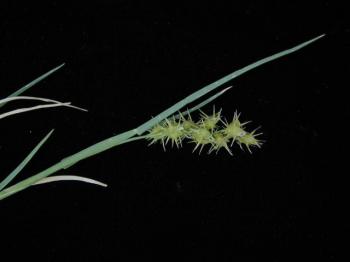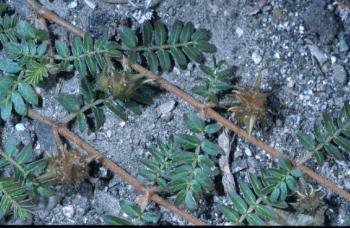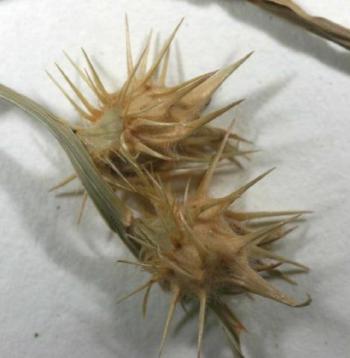February 9, 2019
Controlling Annual Weeds: Timing is Everything with Goatheads and Sandburs
February 9, 2019
Question:
Can you help me battle my weeds organically? I’ve got sandspurs and goatheads. Are there soil conditions weeds hate?
- Helen B., Las Cruces, NM
Answer:
Ouchie, that’s a nasty duo of weedy enemies. Most readers can commiserate all too well. Sandbur is a grass of the Cenchrus genus, also commonly referred to as “stickers” or “sandspurs.” Goatheads (Tribulus terrestris), also known as “puncturevine,” have tiny yellow flowers; delicate, compound leaves; and spiny seeds that are even meaner and tougher than sandburs. Many people mistakenly call sandburs “goatheads,” and I understand why. Both have spiny seeds. Both get all tangled in your socks and shoelaces when you’re not looking. Here’s the quickest way to tell the difference: place one of each seed type on the floor and then step on them both while barefoot. They both hurt, but pay attention to the depth of the pain and the length of time that pain persists. The goathead spines feel like they punctured all the way up to your knee and the spot of contact may ache for over an hour. You’re welcome.

I reached out to NMSU Extension Weed Specialist, Dr. Leslie Beck, for input on strategizing control of these two pesky species:
“Sandburs and goatheads are both summer annual weeds and will certainly respond well to organic options, such as physical removal. Annual plants grow from seed every year when soil conditions (temperature and moisture) are ideal. I would start looking for these weeds to start germinating in Las Cruces within the next few weeks. When nighttime air temperatures start getting into the fifties, it’s a good sign that the soil temperatures and germinating annual weeds will follow shortly.
“The primary idea behind controlling annual weeds is to prevent them from producing seed for next year. As I like to say, ‘The early bird catches the weed.’ This is especially true with hand-pulling because a young germinating plant will not have the opportunity to produce and drop seed; thus, it can’t bother you next growing season. This will take time and consistency as far as management to remove plants as they germinate throughout the spring and possibly throughout the summer. This will also take multiple seasons as the seed that may be lying dormant in your soil (seed bank) has the potential to survive for about 7–10 years with sandbur and goatheads.
“One method that I suggest for trying to pick up any of these ‘sticker-like’ weed seeds is to take an old T-shirt or sheet and drag it across the soil to pick up the stickers. Goatheads are more like thumbtacks, and probably won’t hook onto an old T-shirt like burs will, but if you have a block of Styrofoam from a recently purchased appliance or something, you can press that into the soil surface and pick up any of the goatheads that are there lurking. The root systems on these plants are shallow. Sandbur is a bunch-type grass, and goathead stems cannot root as they spread outward, so it’s easier to try and remove the whole plant, roots and all, with these specific weeds through hand-pulling or using a garden tool such as a trowel, hoe, or a shovel.

“Another option for organic control for both of these weeds might be localized burning through the use of a hand-held propane torch. It’s important to burn as much of the plant that you see on the surface as you can. Of course be careful not to come into contact with plants or materials that can actually catch fire that will spread and cause damage.
“Unfortunately, these are pretty hearty plants that become mature within a short amount of time. There really aren’t organic herbicide options that will yield satisfactory results in injuring or killing these weeds once they’ve started to mature. If you choose to go the organic route, make sure the products have a label with directions for safe and successful applications. DIY mixtures that you see on Facebook and other social media do not have these labels, so it’s difficult to anticipate any negative effects they may have on the soil health, etc. of where they are applied. I’ve seen multiple varieties of labeled organic herbicide products at garden centers. The thing to remember with these products is that they are contact only, meaning they will only affect the portions of the plant they come into contact with; they will have no impact on the root system. This is one of the primary reasons that these options are still recommended for organic management of annual weeds, but they will not be effective with perennial weeds like nutsedge and nightshade. When using organic herbicides on annual plants, uniform coverage of the plant, and making applications when they are very young will help provide greater injury and better control of these weeds.
“As far as soil types, weeds are pretty opportunistic and can grow in multiple soil types, levels of nutrients, moisture, etc. Goatheads can be an indicator of compacted soils or limited nutrients, so tilling the area to allow for water and air movement into the soil and nitrogen fertilization may help. These methods of adjusting management practices will not kill the weeds that you have, but it gives your desired landscape plants a competitive edge and ultimately helps you not to have to address as big of a weed population as you would have before.”

Marisa Y. Thompson, PhD, is the Extension Horticulture Specialist, in the Department of Extension Plant Sciences at the New Mexico State University Los Lunas Agricultural Science Center, email: desertblooms@nmsu.edu, office: 505-865-7340, ext. 113.
Links:
For more gardening information, visit the NMSU Extension Horticulture page at Desert Blooms and the NMSU Horticulture Publications page.
Send gardening questions to Southwest Yard and Garden - Attn: Dr. Marisa Thompson at desertblooms@nmsu.edu, or at the Desert Blooms Facebook page.
Please copy your County Extension Agent and indicate your county of residence when you submit your question!